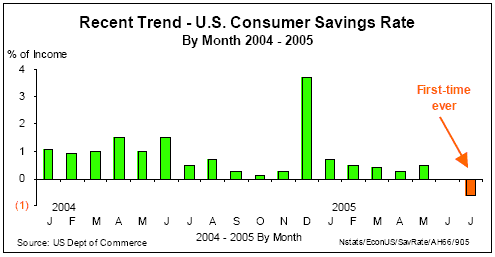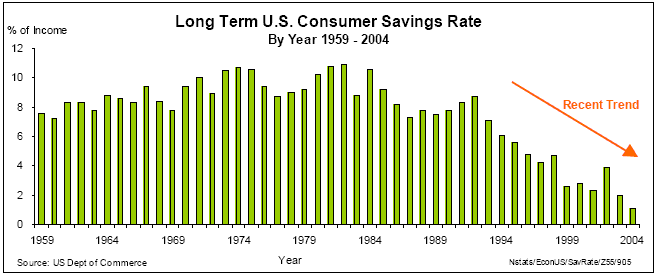IDEX Online Research: Americans’ Savings Rate Goes Negative – They’re Taking Out Money for Spending
September 21, 05
For the first time in history, the closely-watched American “consumer savings rate” went negative. While this key statistic which helps measure personal financial health had declined to nearly zero in recent months, it dropped to a surprisingly negative 0.6% in July.

How can Americans have a negative savings rate? If their spending is greater than their income, the only choice is to raid their personal savings accounts. That’s what happened this summer.
For the past several months, personal income gains have languished. However, personal spending has continued unabated, proving once again that the adage “Americans are born to spend” is true. With a rise in inflation, brought about primarily by soaring gasoline prices, consumers were forced to pull money from their savings accounts to meet current spending needs. It is important to note that this measure of “personal savings” does not recognize any changes in value of other asset classes – appreciating home values or stock market gains – nor does it recognize cash used for debt repayments; it is a simple formula: wages/salaries minus spending equals savings.
Historically, from about 1960 to 1990, the U.S. consumer savings rate was steady in the 7-10% range. However, beginning in the decade of the 1990s, fueled by a surging stock market, rising home prices, a strong job market, and large wage gains, Americans apparently felt comfortable enough to step up their spending and reduce their saving. After all, life’s emergencies could be met by taking out a home equity loan from their bank, by borrowing via a margin account with their stockbroker, or by taking a second or higher-paying job.

What is going on?
- While one month’s bad news does not represent a trend, it could have repercussions over the next several months. If consumers decide to play catch-up, they could cut back on their spending and step up their saving. History has shown that this is an unlikely scenario. Another adage comes to mind: “Baseball may be this country’s national pastime, but shopping is its passion.”
- Most of the excess spending this summer was related to new car purchases. The major Detroit automakers found a new gimmick – “Employee Discounts On All Cars” – an incentive which attracted an unprecedented number of buyers in an otherwise lackluster new car market.
- In the past few weeks, many of the automakers have either curbed or eliminated the “Employee Discount” promotion. Thus, the car-buying surge should abate.
- On the other hand, September is typically a strong month for car purchases, since last year’s models are being flushed out to make room for next year’s new model cars.
- In the past few weeks, many of the automakers have either curbed or eliminated the “Employee Discount” promotion. Thus, the car-buying surge should abate.
- In addition to the consumer savings rate dropping into negative territory, the consumer debt burden continues to climb; it peaked at a record level earlier this year. This weighs heavily on the liability side of consumer balance sheets.
- There are two key offsetting factors to a negative savings rate.
- Home values have continued to climb, though there are some signs that home prices may have peaked in some markets. In the second quarter, U.S. home prices rose at an annualized rate of 13.4%, the largest increase since 1979. While some economists talk about the “bursting of a housing bubble”, we don’t believe that is very likely for two key reasons:
- Fixed assets like a home are basically an illiquid asset – Unlike the volatile stock market, consumers can’t buy and sell homes on a daily basis. Thus, we don’t expect to see any wild swings in home prices.
- Demographic trends suggest continued solid long term demand for housing. Not only are there a large number of well-paid Millennials (young consumers) who are buying their first home, but Baby Boomers (age 40-60) are buying second homes. These two key demographic trends should help support and stabilize home prices.
- Fixed assets like a home are basically an illiquid asset – Unlike the volatile stock market, consumers can’t buy and sell homes on a daily basis. Thus, we don’t expect to see any wild swings in home prices.
- Stock market gains – After four years of treading water, it appears that the stock market may be making some fundamental gains. Equity valuations are reasonable by historical standards and corporate profits are strong after years of cost-cutting.
- Home values have continued to climb, though there are some signs that home prices may have peaked in some markets. In the second quarter, U.S. home prices rose at an annualized rate of 13.4%, the largest increase since 1979. While some economists talk about the “bursting of a housing bubble”, we don’t believe that is very likely for two key reasons:
- One-time catastrophic events typically have little long term impact on consumer spending and saving. After the tragic events of September 2001, consumers said they were going to cut back on spending. Less than six months later (and after reasonably good holiday sales), the consumer spending rate had returned to its pre-9/11 levels and has continued unabated.
- Our worry: with inflation on the rise, driven by higher energy prices – gasoline, utilities, etc. – discretionary spending on luxury goods such as jewelry could be affected short term. We don’t expect across-the-board cutbacks in consumer spending for two reasons:
- High-income consumers (38% of all U.S. households) – those earning over $50,000 a year – account for 73% of all jewelry purchases by value in America. These consumers have the ability to absorb $3 per gallon gasoline without making significant changes in their spending patterns. The typical American family household brings home about $40,800 per year; it’s low-income consumers who will cut back on discretionary purchases such as jewelry.
- Jewelry is a balm for emotionally stressed consumers. Jewelry is a “feel-good” product. When things are tough – for example, we’ve ruffled our wife’s feelings – we give jewelry as penance. Jewelry is a sign of love and affection.
- High-income consumers (38% of all U.S. households) – those earning over $50,000 a year – account for 73% of all jewelry purchases by value in America. These consumers have the ability to absorb $3 per gallon gasoline without making significant changes in their spending patterns. The typical American family household brings home about $40,800 per year; it’s low-income consumers who will cut back on discretionary purchases such as jewelry.
The bottom line: the negative savings rate isn’t the end of the world, but it adds to the uncertainty of consumer spending trends just as we are entering the all-important 2005 holiday selling season.